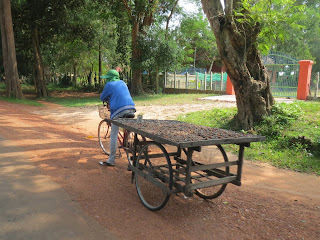- After dinner with Mr. Sarath, he dropped us off to see and hear Dr. Beat Richner, aka Beatocello, the Swiss pediatrician and musician who has built 6 pediatric hospitals (each called Kantha Bopha but Kantha Bopha I, II, etc) that cover 85% of Cambodia's children.
- We had thought we were going to a free cello concert but we should have known better based on what I had read on Trip Advisor about him before leaving home, seeing the massive banners promoting the Saturday concerts going to and from Angkor Wat every day and getting flyers about it every day we passed the entrance to Angkor Wat.
- It may have been billed as a concert but it was more of a commentary on the horrific state of the Cambodian healthcare system and a fundraiser for his hospitals with some music interspersed.
- He asked for money from all of us and blood from the younger audience members, the latter because just one patient earlier in the week had required 18 units of blood!
- We saw a short video about him and the hospitals; when it was made 7 years ago, $5 million has then been raised just through the weekly concerts.
- Richner said 450 children are admitted to the hospitals daily and over 150,000 just last year. In 1992 he built the first children's hospital which "happened" to be on the only street to and from Angkor Wat so all tourists coming to see the temples' sights would have to see the lines of Cambodian parents waiting with their children to see a doctor. 90% of the money spent on saving the children's lives at the hospitals and also inoculating them against children's diseases comes from private donations, much of it from Swiss citizens and their government.
- The hospitals he has set up in Siem Reap and Phnom Penh, Cambodia's capital, and elsewhere employ 2500 Cambodians and only 2 or 3 foreigners, he emphasized.
- Facts and figures I also found alarming about Cambodia: 80% of the population have an income of $1 per day; a farmer's income in cash is only $240 a year. Because of this, all treatment at the hospitals is free.
- Dengue fever and Japanese encephalitis are both rampant in Cambodia; 92% of Cambodian children have been treated/inoculated against the former by the hospitals Richner has set up.
- During the civil war, there had been 300 concentration camps which became a breeding ground for TB which then spread out to the rest of the population like wildfire; Cambodia now has the highest density of TB in the world with 65% of the population infected.
- He talked at length, in between playing the cello, about there being NO public health system in Cambodia; fully 90% of the money running through the Ministry of Health, he said, is lost to corruption. Virtually every Cambodian we spoke to throughout the country decried the massive corruption endemic to the country; also the same story in all the travel literature and Trip Advisor forums I read too so I wasn't surprised about this 90% figure as disturbing as it is.
- The hospitals are, he said, "islands of justice and peace without corruption. Without justice throughout Cambodia, there will never be peace."
- Steven and I both felt we had been in the presence of greatness that night listening to Dr. Beat Richner play his cello and speak of his work in Cambodia.
|











































































No comments:
Post a Comment